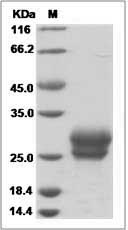-
Product Name
Human Frizzled-4/FZD4/CD344 (His Tag) recombinant protein
- Documents
-
Description
Receptor for Wnt proteins. Most of frizzled receptors are coupled to the beta-catenin (CTNNB1) canonical signaling pathway, which leads to the activation of disheveled proteins, inhibition of GSK-3 kinase, nuclear accumulation of beta-catenin (CTNNB1) and activation of Wnt target genes. Plays a critical role in retinal vascularization by acting as a receptor for Wnt proteins and norrin (NDP). In retina, it can be both activated by Wnt protein-binding, but also by a Wnt-independent signaling via binding of norrin (NDP), promoting in both cases beta-catenin (CTNNB1) accumulation and stimulation of LEF/TCF-mediated transcriptional programs. A second signaling pathway involving PKC and calcium fluxes has been seen for some family members, but it is not yet clear if it represents a distinct pathway or if it can be integrated in the canonical pathway, as PKC seems to be required for Wnt-mediated inactivation of GSK-3 kinase. Both pathways seem to involve interactions with G-proteins. May be involved in transduction and intercellular transmission of polarity information during tissue morphogenesis and/or in differentiated tissues.
-
Protein name
Frizzled-4
-
Protein short names
FRIZZLED FAMILY RECEPTOR 4; FZD4S; FZD4; GPCR; FRIZZLED 4; FZE4; FZ-4; FEVR; FRIZZLED-4; SEVEN TRANSMEMBRANE SPANNING RECEPTOR; FRIZZLED HOMOLOG 4; EVR1; WNT RECEPTOR FRIZZLED-4; HFZ4; FRIZZLED HOMOLOG 4 (DROSOPHILA); MFZ4; FZ4; CD344
-
Uniprot ID
Q9ULV1
-
Gene Name
FZD4
-
Source/Expression Host
Human Cells
-
Expression Plasmid/cDNA
A DNA sequence encoding the human FZD4 (NP_036325.2) (Met1-Glu180) was expressed with a polyhistidine tag at the C-terminus.
-
Protein Species
Human
-
Molecular weight
The recombinant human FZD4 consists 155 amino acids and predicts a molecular mass of 17.7 kDa.
-
Purity
> 95 % as determined by SDS-PAGE.
-
Validations

Human Frizzled-4 / FZD4 / CD344 Protein (His Tag)
Related Products / Services
Please note: All products are "FOR RESEARCH USE ONLY AND ARE NOT INTENDED FOR DIAGNOSTIC OR THERAPEUTIC USE"
